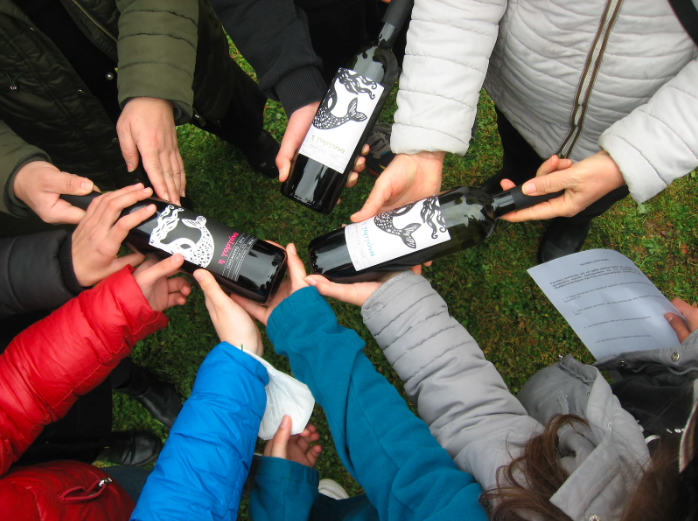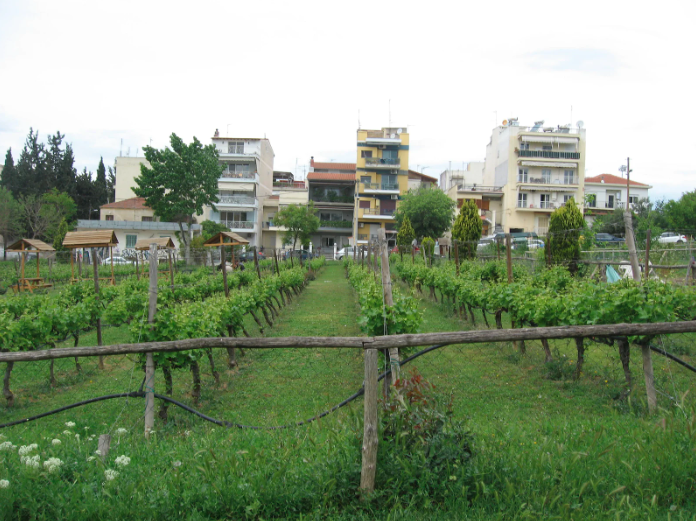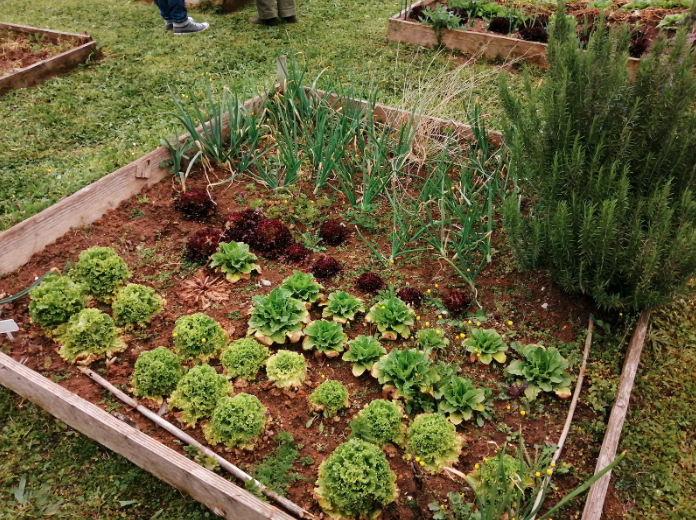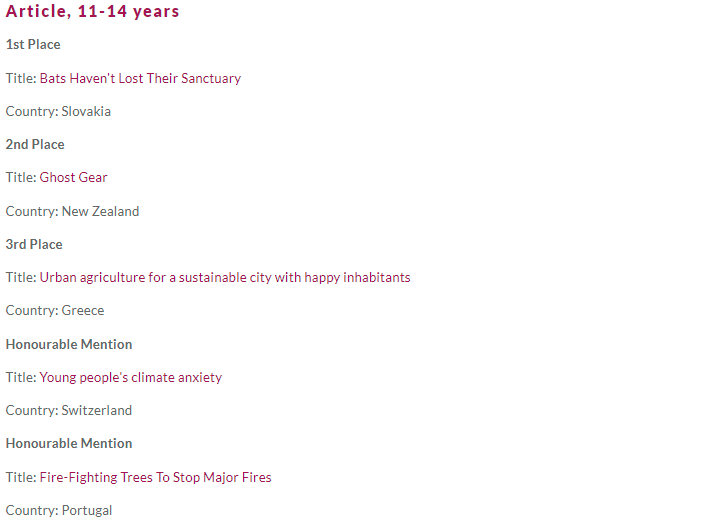YRE Competition 2022
3rd Place - Article
11-14 years old
By Georgia K., Fani O., Eleftheria D., George D., Eleftheria D., Ketevan K.
A green area of the Municipality of Thessaloniki with very special characteristics, unique in Greece, attracted our pedagogical team to deal with it. It is an area of eight acres opposite the Kaftantzogleio Stadium of the city, which houses an urban vineyard, a community vegetable garden and an orchard. It was created in the area of the municipality's vehicles after a decision of the Deputy Mayor for Quality of Life to turn the area into a green area.
The urban vineyard with the community vegetable garden, which is cared for by the locals, is directly related to the phenomenon of biodiversity loss, especially in urban areas, but in the opposite sense. It provides a solution for its development if used as an example for application in many common urban areas, abandoned, neglected and deserted, which are lost urban land, while the locals sit on the balconies of apartment buildings without contact with nature. Activating urban awareness is an important part of developing a city 's biodiversity and sustainability, which is not limited to green spaces, traditional constructions, improved energy systems and recycling.
On April 5, 2022 our team visited the urban vineyard. There we were welcomed and hosted by the Head of Urban Environment Management of the Municipality of Thessaloniki Mr. Matziris with his associates and the Head of the Environmental Training Center Eleftherios Kordelios Mrs. Athanassiou.
In an interview, Mr. Matziris answered questions from students, which focused a) on data related to the urban vineyard, such as what existed in the past in his area, when and who pioneered its creation, how many vines were planted, from what varieties, what is the future planning for further utilization of the remaining space and b) in the community vegetable garden that extends north of the vineyard.
Before the 2004 Olympic Games, the area was a parking lot and maintenance site for the Municipality's garbage trucks. The vineyard was created in 2013. It occupies 2 acres of a total area of 8 acres. Next to it, urban gardens and an orchard were created. The municipality planted 480 vines, 120 roots of each variety. It hosts the Greek wine white varieties robola, malagouzia and the red agiorgitiko and xinomavro.
The first wine was produced in 2014. The cultivation of the urban vineyard is completely organic. The wine "Gorgona" that produces and took its name from the sister of Alexander the Great, is not for sale, but is given at charity dinners and activities of the Municipality of Thessaloniki.
Three bodies participated in its creation: a) A public body, the services of the Municipality of Thessaloniki under Mayor I. Boutari and Deputy Mayor in the Quality of Life department, current Mayor of Thessaloniki, K. Zerva, b) an educational / research body, the Laboratory Viticulture of the Agricultural School of AUTh. and c) a private and business entity, the Gerovasiliou Estate. The care of the plants was undertaken by employees of the municipality and students of the Viticulture Laboratory.
The vineyard is a "green" place in the heart of the city where people of all ages can enjoy the fresh air and sunbathe on the specially designed benches that have been installed next to the vineyards, to communicate, to share thoughts, feelings, expectations. It is visited by schools and tourists.
The creation of an urban winery is experiencing a boom in recent years worldwide. In Montmartre there is a vineyard under the auspices of the city of Paris. The first vineyard of London is located on the northern borders of metropolitan London. The Dorina variety is revived in the lagoon of Venice, which was the wine preferred by the Doges. There is also a vineyard on the roofs of Brooklyn in New York covering an area of 1400 sq.m. In Vienna, vines are grown on 6,000 acres just a few metro stops outside the city.
Τhe small fenced gardens that extend in the area after the vineyard is the result of the intervention of students of the department of architecture, within the framework of a European program, in collaboration with the locals. The area was chosen for the development of urban agriculture, that is the creation of a green area with a different role and function, which can activate the neighbourhood. The community vegetable garden operates in support of and in addition to the vineyard, currently occupying an area of 1 acre. At the same time, on the occasion of the 100th anniversary of the liberation of the city, an orchard was created by planting 100 fruit trees.
In the future it is planned to create a small information kiosk for the activities of the area and for recycling issues. There is a thought of creating spaces of similar function in other areas of the city with the cooperation of the municipal community, as well as the creation of the so-called "pocket" parks, that is small neighbourhood parks utilized in this direction, making a passage through the lawn and ornamental plants to urban agriculture.
It is obvious, as Mrs. Athanassiou emphasized too, that if neighbourhood gardens are constructed in various remaining areas of the city that remain useless, food adequacy will be ensured for a large part of the population that is below the poverty line. Since the vast majority of the inhabitants of a big city live in apartments, in a way the urban gardens have replaced the gardens of the houses, constituting the yard of the neighbourhood. In addition, they are a place of meeting and communication of the inhabitants of the area.
To summarize, the Community vegetable garden and urban vineyard create a rich urban green environment by attracting other living organisms, such as insects and birds, thus contributing to the increase of biodiversity in the urban environment. They also create a space for communication and meeting of the neighbourhoods in the isolation of life in the buildings of big cities. In addition, their systematic, extensive application in other areas of the same city or other cities that meet the requirements, will help combat climate change and can provide food to part of the urban population that is malnourished. Based on the above, these two elements of urban agriculture that occupied the group, contribute to the promotion of the three dimensions of sustainable development - social, environmental, economic - based on Agenda 2030. They directly serve the goals of sustainable development that refer to sustainable cities and communities, climate action and zero hunger. The fact that the urban environment affects the physical, social and mental condition of the inhabitants and ensures health, also enhances the achievement of the goal related to good health and well-being. In general, the goal of ensuring life on land is also served in the urban environment by combating desertification and reversing soil degradation and biodiversity.
We invite you all, students and teachers, to visit it! You will get acquainted with the vineyard, urban agriculture and ecology!
Pictures from the community vegetable garden
Bottles of ¨Gorgona¨ wine available in charity dinners of the Municipality of Thessaloniki
The urban vineyard on April
Pictures from the community vegetable garden
REFERENCES:
https://vinoterra.gr/cava/2016/08/03/αστικοί-αμπελώνες-urban-vineyards
https://thessaloniki.gr/trigos-ston-astiko-ampelona-tou-dimou-thessalonikis/
https://www.kpe-thess.gr/download/ekdoseis/ekpaideytiko_yliko/Biwsimi_Poli.pdf
https://gslegal.gov.gr/?page_id=5506
DISSEMINATION:
https://11gym-thess.thess.sch.gr/?p=2071
http://blogs.sch.gr/11gymthe/files/2022/04/ΠΑΡΟΥΣΙΑΣΗ-ΑΣΤΙΚ-ΑΜΠΕΛ-ΣΧΟΛΕΙΟ-ΙΣΤ-ΝΕΟ.pdf
https://twinspace.etwinning.net/238206/materials/files
https://eepf.gr/el/el-nea/apotelesmata-ethnikou-diagonismou-yre-2022





